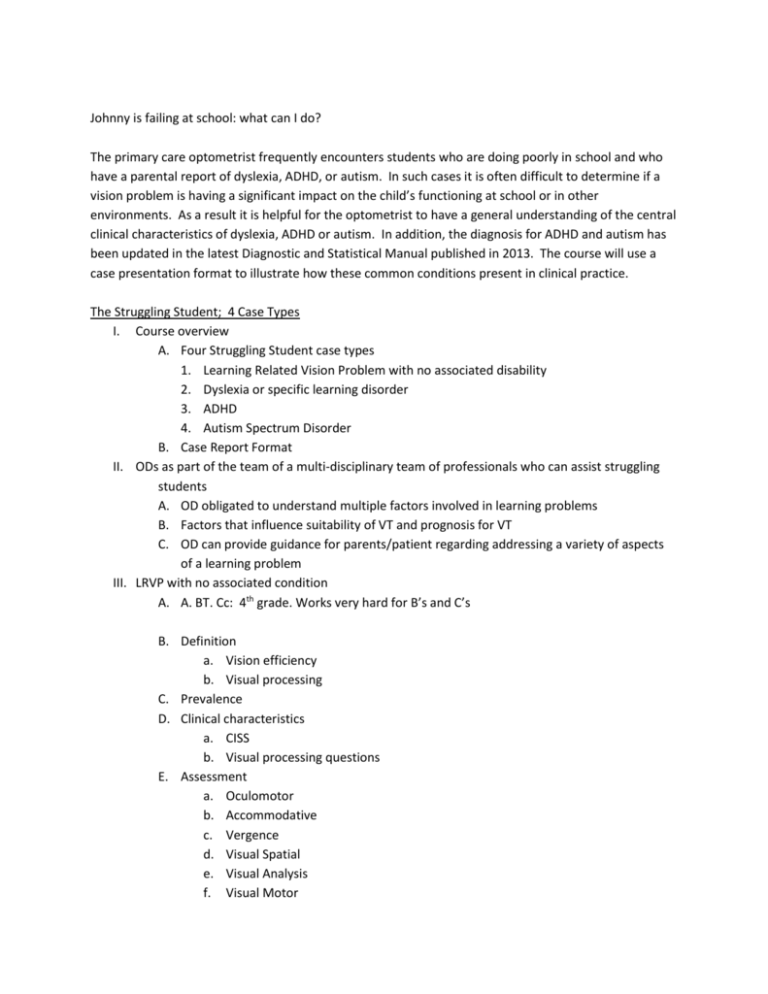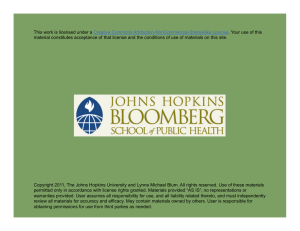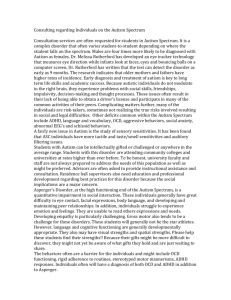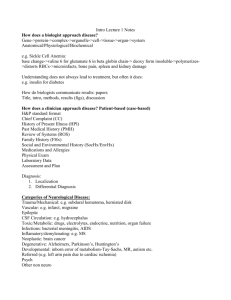Outline BV
advertisement

Johnny is failing at school: what can I do? The primary care optometrist frequently encounters students who are doing poorly in school and who have a parental report of dyslexia, ADHD, or autism. In such cases it is often difficult to determine if a vision problem is having a significant impact on the child’s functioning at school or in other environments. As a result it is helpful for the optometrist to have a general understanding of the central clinical characteristics of dyslexia, ADHD or autism. In addition, the diagnosis for ADHD and autism has been updated in the latest Diagnostic and Statistical Manual published in 2013. The course will use a case presentation format to illustrate how these common conditions present in clinical practice. The Struggling Student; 4 Case Types I. Course overview A. Four Struggling Student case types 1. Learning Related Vision Problem with no associated disability 2. Dyslexia or specific learning disorder 3. ADHD 4. Autism Spectrum Disorder B. Case Report Format II. ODs as part of the team of a multi-disciplinary team of professionals who can assist struggling students A. OD obligated to understand multiple factors involved in learning problems B. Factors that influence suitability of VT and prognosis for VT C. OD can provide guidance for parents/patient regarding addressing a variety of aspects of a learning problem III. LRVP with no associated condition A. A. BT. Cc: 4th grade. Works very hard for B’s and C’s B. Definition a. Vision efficiency b. Visual processing C. Prevalence D. Clinical characteristics a. CISS b. Visual processing questions E. Assessment a. Oculomotor b. Accommodative c. Vergence d. Visual Spatial e. Visual Analysis f. Visual Motor F. Clinical Case a. Vision Efficiency b. Visual processing c. Key results and factors influencing prognosis G. Plan: VT H. Outcome IV. Dyslexia or Specific Learning Disorder –Case 2 A. Definition B. Prevalence C. Methods of diagnosis a. Common reading tests b. Role of language D. Clinical Characteristics a. Simple model of reading b. Decoding problem i. Phonetic ii. Eidetic c. Comprehension i. Role of oral language d. Associations with Dyslexia E. Common treatments a. Multi-sensory reading therapy b. Examples F. Case 2 a. Vision efficiency b. Visual processing c. Screening for reading d. Key results and factors influencing prognosis V. ADHD – Case 3 A. Definition B. Prevalence C. Methods of diagnosis a. Clinical interview b. Parent survey c. Teacher survey D. Clinical characteristics a. Inattentive b. Hyperactive/Impulsive c. Co-morbid conditions E. F. G. H. d. Other factors Common treatments a. Behavioral b. Medication i. Stimulant medications ii. Other medications c. Other treatments Case 3 a. Vision efficiency b. Visual processing c. Screening for reading d. Key results and factors influencing prognosis Plan Outcome VI. Autism Spectrum Disorder – Case 4 A. Definition B. Prevalence C. Methods of diagnosis a. Clinical interview b. Common surveys D. Clinical characteristics a. Social/communicative disorder b. Fixed interest and repetitive behavior c. Symptoms must be present in early childhood d. Symptoms limit and impair everyday functioning E. Common Treatments a. Early intervention b. School based intervention c. Medications I. Case 4 a. Vision efficiency b. Visual processing c. Screening for reading d. Key results and factors influencing prognosis J. Plan K. Outcome Learning Objectives The attendee will be able to list the assessment procedures used to diagnosis a child with learning related visual skill problems. The attendee will be able to identify screening tests for school-aged children with dyslexia. The attendee will be a able to list the inattentive and hyperactive/impulsive characteristics of ADHD The attendee will be to identify three clinical features of autism. The attended will be able to identify positive and negative prognostic indicators for outcomes in children with visual problems and co-occurring disabilities. Reading References Garzia RP, Borsting EJ, Nicholson SB, et. al. Care of the Patient with Learning Related Vision Problems Optometric Clinical Practice Guideline. American Optometric Association, St. Louis MO. 2008 (revised) Griffin JR, Christenson GN, Wesson MD et. al. Optometric Management of Reading Dysfunction. Butterworth-Heinemann, Boston 1997. Robinson RG. Autism Solutions. Harlequin, Ontario Canada 2011 Scheiman MM, Rouse MW. Optometric Management of Learning-Related Vision Problems, 2nd ed. Mosby inc, St. Louis 2006







